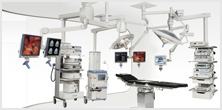About
At Olympus, we are committed to Our Purpose of making people’s lives healthier, safer and more fulfilling. As a global medical technology company, we partner with healthcare professionals to provide best-in-class solutions and services for early detection, diagnosis, and minimally invasive treatment, aiming to improve patient outcomes by elevating the standard of care in targeted disease states.
For more than 100 years, Olympus has pursued a goal of contributing to society by producing products designed with the purpose of delivering optimal outcomes for its customers around the world.
Olympus Corporation of the Americas, a wholly owned subsidiary of Olympus Corporation, is headquartered in Center Valley, Pennsylvania, USA, and employs more than 4,500 employees throughout locations in North and South America. For more information, visit www.olympusamerica.com.
Our Company
See how Olympus is passionate about creating customer-driven solutions for the medical industry.
Careers
Help us make people's lives healthier, safer and more fulfilling. Visit our Careers page to learn more about the many exciting opportunities available with Olympus.
Corporate Social Responsibility
Learn more about Olympus' commitment to the betterment of society.
Patient Information
Visit our patient information sites on CRC, BHP and hysterectomies to learn more about these conditions and how our technologies can help.
Olympus Events
Access upcoming and previously recorded webinars, view our trade show schedule, and register for hands-on courses, online learning, lectures and workshops, peer-to-peer training, accredited continuing education, and custom on-demand learning.
About AdvaMed
AdvaMed promotes policies that foster the higest ethical standards, rapid product approvals, appropirate reimbursement, and access to international markets.
Contact
Visit our contact page to locate the resource you need for assistance with or information about our Olympus products.
Technology
Olympus has been renowned as a pioneer in developing innovative technologies that enable physicians and surgeons peer inside the human body
Awards
Olympus' roots in innovation, healthcare and service to humanity date back nearly a century. Our first product was a microscope, introduced in Japan in 1920. Today, Olympus’ award-winning products are renowned around the globe for their optical excellence.













































